Wastewater Impact on Surface Water Quality and Suitability of Water Reuse in Agriculture Using a Comprehensive Methodology Based on PCA and Specific Indices
Abstract
1. Introduction
- (i)
- To assess surface water quality based on Water Quality Index (WQI) using PCA.
- (ii)
- To assess the effectiveness of wastewater treatment processes at a designated wastewater treatment plant (WWTP). This involves assessing how well the treatment processes remove contaminants and pollutants from wastewater before it is discharged into the environment.
- (iii)
- To evaluate suitability for irrigation using a set of physico-chemical parameters—electrical conductivity (EC), total dissolved solids (TDSs), turbidity, and Biochemical Oxygen Demand (BOD5); and specific irrigation indices—Sodium Adsorption Ratio (SAR), Permeability Index (PI), Residual Sodium Carbonate (RSC), Sodium Percentage (%Na), and Kelly’s ratio (KR).
2. Materials and Methods
2.1. Case Study and Methodological Framework
2.2. Sample Collection and Laboratory Analysis
2.3. Data Processing
2.4. The Efficiency of the Treatment Processes
2.5. Water Quality Index (WQI)
- x is the value of the data point;
- μ is the mean of the data;
- σ is the standard deviation of the data.
2.6. Irrigation Water Quality Index (IWQI) Calculation
3. Results and Discussions
| Parameters | Quality Standard | Mean (M) | Standard Deviation (SD) | Min | Max | Legal Standard |
|---|---|---|---|---|---|---|
| pH | 6.5–8.5 | 7.2 | 0.3 | 6.6 | 7.9 | Order No. 161/2006 (Quality class I) [44] |
| EC (µS/cm) | 1000 | 84.8 | 57.7 | 44.1 | 280 | WHO (2022) [46] |
| TDS (mg/L) | 500 | 54.9 | 36.2 | 29 | 181 | USEPA (2018) [48] |
| Turbidity (NTU) | 5 | 4.3 | 6.1 | 0.08 | 32.4 | WHO (2024) [47] |
| Alkalinity (mg/L) | - | 58.6 | 24.7 | 24.4 | 140.3 | - |
| Na+ (mg/L) | 25 | 15.9 | 7.8 | 7.8 | 42.5 | Order No. 161/2006 (Quality class I) [44] |
| K+ (mg/L) | 20 | 0.5 | 0.6 | 0.1 | 3.1 | WHO (2022) [46] |
| Mg2+ (mg/L) | 12 | 1.3 | 0.8 | 0.6 | 4.2 | Order No. 161/2006 (Quality class I) [44] |
| Ca2+ (mg/L) | 50 | 2.9 | 2.3 | 1.1 | 12.8 | Order No. 161/2006 (Quality class I) [44] |
| Cl− (mg/L) | 25 | 19.02 | 8.7 | 10.2 | 48.4 | Order No. 161/2006 (Quality class I) [44] |
| N_NO3− (mg/L) | 1 | 0.3 | 0.2 | 0.09 | 1.4 | Order No. 161/2006 (Quality class I) [44] |
| SO42− (mg/L) | 60 | 15.7 | 14.4 | 3.2 | 68.5 | Order No. 161/2006 (Quality class I) [44] |
| P_PO43− (mg/L) | 0.1 | 0.06 | 0.05 | 0.03 | 0.2 | Order No. 161/2006 (Quality class I) [44] |
| HCO3− (mg/L) | 120 | 1.6 | 0.3 | 0.7 | 2.5 | WHO (2017) [45] |
| Parameters | Quality Standard | Mean (M) | Standard Deviation (SD) | Min | Max | Legal Standard |
|---|---|---|---|---|---|---|
| pH | 6.5–8.5 | 7 | 0.3 | 6.4 | 7.5 | NTPA–001/2002 [10] |
| EC (µS/cm) | - | 389 | 52.8 | 251 | 461 | |
| TDS (mg/L) | - | 253 | 34.6 | 163 | 300 | |
| Turbidity (NTU) | - | 1.7 | 1.2 | 0.3 | 4.4 | |
| Alkalinity (mg/L) | - | 159 | 30.4 | 115 | 207 | |
| BOD5 (mg/L) | 25 | 3.6 | 3.8 | 0.4 | 15.3 | NTPA–001/2002 [10] |
| Na+ (mg/L) | - | 70.8 | 8.4 | 48.7 | 78.9 | |
| K+ (mg/L) | - | 1.6 | 1.06 | 0.2 | 4.2 | |
| Mg2+ (mg/L) | 100 | 4.3 | 1.9 | 2.1 | 8.5 | NTPA–001/2002 [10] |
| Ca2+ (mg/L) | 300 | 8.5 | 4.6 | 3.9 | 17.2 | NTPA–001/2002 [10] |
| Cl− (mg/L) | 500 | 86.8 | 14.2 | 58.7 | 109 | NTPA–001/2002 [10] |
| NO3− (mg/L) | 25 | 6.3 | 3.4 | 0.8 | 11.8 | NTPA–001/2002 [10] |
| SO42− (mg/L) | 600 | 61.8 | 17.6 | 30.5 | 97.5 | NTPA–001/2002 [10] |
| PO43− (mg/L) | - | 0.1 | 0.1 | 0.1 | 0.4 | |
| HCO3− (mg/L) | - | 3.07 | 1.2 | 1.2 | 5.2 |
3.1. Seasonal Variation
3.2. The Efficiency of the Treatment Processes
3.3. Water Quality Index (WQI) Results
3.3.1. PCA
3.3.2. WQI Calculation
3.4. Assessment of the Suitability of Treated Wastewater for Irrigation Purposes
| Parameters | Value Range | Water Classification | References | Number of Samples |
|---|---|---|---|---|
| EC (µS/cm) | <250 | Excellent | Richards, 1954; Thirumoorthy et al., 2024 [51,67] | 0 |
| 250–750 | Good | 17 | ||
| 750–2000 | Permissible | 0 | ||
| 2000–3000 | Doubtful | 0 | ||
| >3000 | Unsuitable | 0 | ||
| TDS (mg/L) | <450 | Suitable | Ayers and Westcot, 1985; Bhatti et al., 2019 [79,80] | 17 |
| 450–2000 | Moderate | 0 | ||
| >2000 | Unsuitable | 0 | ||
| Turbidity (NTU) | ≤5 | Suitable | Regulation 741/2020 [15] | 17 |
| >5 | Unsuitable | 0 | ||
| BOD5 (mg/L) | ≤10 | Suitable | Regulation 741/2020 [15] | 16 |
| >10 | Unsuitable | 1 | ||
| SAR | <10 | Excellent | Richards, 1954; Shil et al., 2019 [67,81] | 17 |
| 10–18 | Good | 0 | ||
| 18–26 | Doubtful | 0 | ||
| >26 | Unsuitable | 0 | ||
| PI% | >75% | Suitable | Das and Nag, 2015 [68] | 15 |
| 20–75% | Moderate | 2 | ||
| <25% | Unsuitable | 0 | ||
| RSC | <1.25 | Suitable | Eaton, 1950 [71] | 17 |
| 1.25–2.5 | Moderate | 0 | ||
| >2.5 | Unsuitable | 0 | ||
| %Na | <20 | Excellent | Wilcox, 1955 [72] | 0 |
| 20–40 | Good | 0 | ||
| 40–60 | Permissible | 0 | ||
| 60–80 | Doubtful | 5 | ||
| >80 | Unsuitable | 12 | ||
| KR | ≤1 | Suitable | Kelley, 1963 [73] | 0 |
| >1 | Unsuitable | 17 |
4. Conclusions
Author Contributions
Funding
Data Availability Statement
Conflicts of Interest
References
- Okello, C.; Tomasello, B.; Greggio, N.; Wambiji, N.; Antonellini, M. Impact of Population Growth and Climate Change on the Freshwater Resources of Lamu Island, Kenya. Water 2015, 7, 1264–1290. [Google Scholar] [CrossRef]
- Rezapour, S.; Alamdari, P.; Kalavrouziotis, I.K. Response of Soil Health Index to Untreated Wastewater Irrigation in Selected Farms under Different Vegetable Types. Agric. Water Manag. 2023, 290, 108592. [Google Scholar] [CrossRef]
- Radini, S.; González-Camejo, J.; Andreola, C.; Eusebi, A.L.; Fatone, F. Risk Management and Digitalisation to Overcome Barriers for Safe Reuse of Urban Wastewater for Irrigation—A Review Based on European Practice. J. Water Process Eng. 2023, 53, 103690. [Google Scholar] [CrossRef]
- Wang, Z.; Li, X.; Xiang, S. Assessing de Facto Wastewater Reuse and Its Implications for Water Quality in Yangtze Basin (2014–2021). Heliyon 2024, 10, e40275. [Google Scholar] [CrossRef]
- Carvalho, A.R.; Pérez-Pereira, A.I.; Couto, C.M.C.; Tiritan, M.E.; Ribeiro, C.M.R. Assessment of Effluents Quality through Ecotoxicological Assays: Evaluation of Three Wastewater Treatment Plants with Different Technologies. Environ. Sci. Pollut. Res. 2022, 29, 963–976. [Google Scholar] [CrossRef]
- Foglia, A.; González-Camejo, J.; Radini, S.; Sgroi, M.; Li, K.; Eusebi, A.L.; Fatone, F. Transforming Wastewater Treatment Plants into Reclaimed Water Facilities in Water-Unbalanced Regions. An Overview of Possibilities and Recommendations Focusing on the Italian Case. J. Clean. Prod. 2023, 410, 137264. [Google Scholar] [CrossRef]
- Moretti, A.; Ivan, H.L.; Skvaril, J. A Review of the State-of-the-Art Wastewater Quality Characterization and Measurement Technologies. Is the Shift to Real-Time Monitoring Nowadays Feasible? J. Water Process Eng. 2024, 60, 105061. [Google Scholar] [CrossRef]
- Council of the European Communities. Council Directive of 21 May 1991 Concerning Urban Waste Water Treatment; Office for Official Publications of the European Communities: Luxembourg City, Luxembourg, 1991. [Google Scholar]
- HG 188 28/02/2002—Portal Legislativ. Available online: https://legislatie.just.ro/Public/DetaliiDocument/34651 (accessed on 21 November 2024).
- Romanian Parliament NTPA-001-2002. Available online: https://pierderideapa.wordpress.com/wp-content/uploads/2015/07/ntpa-001-28-02-2002.pdf (accessed on 21 November 2024).
- Romanian Parliament NTPA-002/2002. Available online: https://pierderideapa.wordpress.com/wp-content/uploads/2015/07/ntpa-002-28-02-2002.pdf (accessed on 21 November 2024).
- Romanian Parliament NTPA-011/2002. Available online: https://pierderideapa.wordpress.com/wp-content/uploads/2015/07/ntpa-011-28-02-2002.pdf (accessed on 21 November 2024).
- European Commission. Joint Research Centre. Minimum Quality Requirements for Water Reuse in Agricultural Irrigation and Aquifer Recharge: Towards a Water Reuse Regulatory Instrument at EU Level; Publications Office: Luxembourg City, Luxembourg, 2017. [Google Scholar]
- Truchado, P.; Gil, M.I.; López, C.; Garre, A.; López-Aragón, R.F.; Böhme, K.; Allende, A. New Standards at European Union Level on Water Reuse for Agricultural Irrigation: Are the Spanish Wastewater Treatment Plants Ready to Produce and Distribute Reclaimed Water within the Minimum Quality Requirements? Int. J. Food Microbiol. 2021, 356, 109352. [Google Scholar] [CrossRef]
- Regulation—2020/741—EN—EUR-Lex. Available online: https://eur-lex.europa.eu/eli/reg/2020/741/oj (accessed on 20 November 2024).
- Procházková, M.; Touš, M.; Horňák, D.; Miklas, V.; Vondra, M.; Máša, V. Industrial Wastewater in the Context of European Union Water Reuse Legislation and Goals. J. Clean. Prod. 2023, 426, 139037. [Google Scholar] [CrossRef]
- Romanian Parliament Ordonanta de Urgenta 52 31/05/2023. Available online: https://legislatie.just.ro/Public/DetaliiDocument/271163 (accessed on 21 November 2024).
- Sun, Y.; Chen, Z.; Wu, G.; Wu, Q.; Zhang, F.; Niu, Z.; Hu, H.-Y. Characteristics of Water Quality of Municipal Wastewater Treatment Plants in China: Implications for Resources Utilization and Management. J. Clean. Prod. 2016, 131, 1–9. [Google Scholar] [CrossRef]
- Horton, R.K. An Index Number System for Rating Water Quality. J. Water Pollut. Control Fed. 1965, 37, 300–306. [Google Scholar]
- Mukate, S.; Wagh, V.; Panaskar, D.; Jacobs, J.A.; Sawant, A. Development of New Integrated Water Quality Index (IWQI) Model to Evaluate the Drinking Suitability of Water. Ecol. Indic. 2019, 101, 348–354. [Google Scholar] [CrossRef]
- Sutadian, A.D.; Muttil, N.; Yilmaz, A.G.; Perera, B.J.C. Development of River Water Quality Indices—A Review. Environ. Monit. Assess. 2016, 188, 58. [Google Scholar] [CrossRef]
- Benaissa, M.; Gueroui, Y.; Guettaf, M.; Boudalia, S.; Bousbia, A.; Ouartsi, A.; Maoui, A. Hydrochemical Characterization and Evaluation of Irrigation Water Quality Using Indexing Approaches, Multivariate Analysis, and GIS Techniques in K’sob Valley, Algeria. J. Afr. Earth Sci. 2024, 219, 105385. [Google Scholar] [CrossRef]
- Pany, R.; Rath, A.; Swain, P.C. Water Quality Assessment for River Mahanadi of Odisha, India Using Statistical Techniques and Artificial Neural Networks. J. Clean. Prod. 2023, 417, 137713. [Google Scholar] [CrossRef]
- Mahanty, B.; Lhamo, P.; Sahoo, N.K. Inconsistency of PCA-Based Water Quality Index—Does It Reflect the Quality? Sci. Total Environ. 2023, 866, 161353. [Google Scholar] [CrossRef]
- Nnorom, I.C.; Ewuzie, U.; Eze, S.O. Multivariate Statistical Approach and Water Quality Assessment of Natural Springs and Other Drinking Water Sources in Southeastern Nigeria. Heliyon 2019, 5, e01123. [Google Scholar] [CrossRef]
- Sabinaya, S.; Mahanty, B.; Rout, P.R.; Raut, S.; Sahoo, S.K.; Jha, V.; Sahoo, N.K. Multi-Model Exploration of Groundwater Quality and Potential Health Risk Assessment in Jajpur District, Eastern India. Environ. Geochem. Health 2024, 46, 57. [Google Scholar] [CrossRef]
- Gad, M.; Elsayed, S.; Moghanm, F.S.; Almarshadi, M.H.; Alshammari, A.S.; Khedher, K.M.; Eid, E.M.; Hussein, H. Combining Water Quality Indices and Multivariate Modeling to Assess Surface Water Quality in the Northern Nile Delta, Egypt. Water 2020, 12, 2142. [Google Scholar] [CrossRef]
- Elsayed, S.; Ibrahim, H.; Hussein, H.; Elsherbiny, O.; Elmetwalli, A.H.; Moghanm, F.S.; Ghoneim, A.M.; Danish, S.; Datta, R.; Gad, M. Assessment of Water Quality in Lake Qaroun Using Ground-Based Remote Sensing Data and Artificial Neural Networks. Water 2021, 13, 3094. [Google Scholar] [CrossRef]
- Adilakshmi, A.; Venkatesan, V. Effective Monitoring of Noyyal River Surface Water Quality Using Remote Sensing and Machine Learning and GIS Techniques. Desalination Water Treat. 2024, 320, 100630. [Google Scholar] [CrossRef]
- Anyango, G.W.; Bhowmick, G.D.; Sahoo Bhattacharya, N. A Critical Review of Irrigation Water Quality Index and Water Quality Management Practices in Micro-Irrigation for Efficient Policy Making. Desalination Water Treat. 2024, 318, 100304. [Google Scholar] [CrossRef]
- Hassan, H.B.; Moniruzzaman, M.; Majumder, R.K.; Ahmed, F.; Bhuiyan, M.A.Q.; Ahsan, M.A.; Al-Asad, H. Impacts of Seasonal Variations and Wastewater Discharge on River Quality and Associated Human Health Risks: A Case of Northwest Dhaka, Bangladesh. Heliyon 2023, 9, e18171. [Google Scholar] [CrossRef]
- Hayeri Yazdi, S.; Robati, M.; Samani, S.; Zamani Hargalani, F. Assessing the Sustainability of Groundwater Quality for Irrigation Purposes Using a Fuzzy Logic Approach. Environ. Sustain. Indic. 2024, 22, 100342. [Google Scholar] [CrossRef]
- Salem, S.; Gaagai, A.; Ben Slimene, I.; Moussa, A.; Zouari, K.; Yadav, K.; Eid, M.; Abukhadra, M.; El-Sherbeeny, A.; Gad, M.; et al. Applying Multivariate Analysis and Machine Learning Approaches to Evaluating Groundwater Quality on the Kairouan Plain, Tunisia. Water 2023, 15, 3495. [Google Scholar] [CrossRef]
- Gad, M.; Saleh, A.H.; Hussein, H.; Elsayed, S.; Farouk, M. Water Quality Evaluation and Prediction Using Irrigation Indices, Artificial Neural Networks, and Partial Least Square Regression Models for the Nile River, Egypt. Water 2023, 15, 2244. [Google Scholar] [CrossRef]
- Elsayed, S.; Hussein, H.; Moghanm, F.S.; Khedher, K.M.; Eid, E.M.; Gad, M. Application of Irrigation Water Quality Indices and Multivariate Statistical Techniques for Surface Water Quality Assessments in the Northern Nile Delta, Egypt. Water 2020, 12, 3300. [Google Scholar] [CrossRef]
- Mishra, S.; Kumar, R.; Kumar, M. Use of Treated Sewage or Wastewater as an Irrigation Water for Agricultural Purposes- Environmental, Health, and Economic Impacts. Total Environ. Res. Themes 2023, 6, 100051. [Google Scholar] [CrossRef]
- Hosney, H.; Tawfik, M.H.; Duker, A.; Van Der Steen, P. Prospects for Treated Wastewater Reuse in Agriculture in Low- and Middle-Income Countries: Systematic Analysis and Decision-Making Trees for Diverse Management Approaches. Environ. Dev. 2023, 46, 100849. [Google Scholar] [CrossRef]
- INSSE—Baze de Date Statistice—TEMPO-Online Serii de Timp. Available online: http://statistici.insse.ro/shop/ (accessed on 20 November 2024).
- Ministry of Environment, Waters and Forests, Romania. Flood Risk Management Plan—Mures; Ministry of Environment, Waters and Forests: Bucharest, Romania, 2023. [Google Scholar]
- Sebes Municipality. Integrated Urban Development Strategy 2021–2030; Sebes Municipality: Sebes, Romania, 2022. [Google Scholar]
- ISO 5667-1:2023; Water Quality—Sampling—Part 1: Guidance on the Design of Sampling Programmes and Sampling Techniques. International Organization for Standardization: Geneva, Switzerland, 2023.
- ISO 5667-3:2024; Water Quality—Sampling—Part 3: Preservation and Handling of Water Samples. International Organization for Standardization: Geneva, Switzerland, 2024.
- ISO 5667-6:2014; Water Quality—Sampling—Part 6: Guidance on Sampling of Rivers and Streams. International Organization for Standardization: Geneva, Switzerland, 2014.
- Romanian Parliament Ordin 161 16/02/2006. Available online: https://legislatie.just.ro/Public/DetaliiDocument/72574 (accessed on 21 November 2024).
- World Health Organization. WHO Guidelines for Drinking-Water Quality: First Addendum to the Fourth Edition; World Health Organization: Geneva, Switzerland, 2017. [Google Scholar]
- World Health Organization. WHO Guidelines for Drinking-Water Quality: Incorporating the First and Second Addenda; World Health Organization: Geneva, Switzerland, 2022; ISBN 92-4-004506-6. [Google Scholar]
- World Health Organization. WHO Guidelines for Drinking-Water Quality: Small Water Supplies; World Health Organization: Geneva, Switzerland, 2024; p. 220. [Google Scholar]
- U.S. Environmental Protection Agency. 2018 Edition of the Drinking Water Standards and Health Advisories Tables; US Environmental Protection Agency: Washington, DC, USA, 2018. [Google Scholar]
- Arabzadeh, M.; Eslamidoost, Z.; Rajabi, S.; Hashemi, H.; Aboulfotoh, A.; Rosti, F.; Nazari, F.; Pouladi Borj, B.; Hajivand, M. Wastewater Quality Index (WWQI) as an Indicator for the Assessment of Sanitary Effluents from the Oil and Gas Industries for Reliable and Sustainable Water Reuse. Groundw. Sustain. Dev. 2023, 23, 101015. [Google Scholar] [CrossRef]
- Lumb, A.; Sharma, T.C.; Bibeault, J.-F. A Review of Genesis and Evolution of Water Quality Index (WQI) and Some Future Directions. Water Qual. Expo. Health 2011, 3, 11–24. [Google Scholar] [CrossRef]
- Thirumoorthy, P.; Velusamy, S.; Nallasamy, J.L.; Shanmugamoorthy, M.; Sudalaimuthu, G.; Veerasamy, S.; Periyasamy, M.; Murugasamy, M.V. Evaluation of Groundwater Quality for Irrigation Purposes in Hard Rock Terrain of Southern India Using Water Quality Indices Modelling. Desalination Water Treat. 2024, 318, 100397. [Google Scholar] [CrossRef]
- Benkov, I.; Varbanov, M.; Venelinov, T.; Tsakovski, S. Principal Component Analysis and the Water Quality Index—A Powerful Tool for Surface Water Quality Assessment: A Case Study on Struma River Catchment, Bulgaria. Water 2023, 15, 1961. [Google Scholar] [CrossRef]
- Ajtai, I.; Ștefănie, H.; Maloș, C.; Botezan, C.; Radovici, A.; Bizău-Cârstea, M.; Baciu, C. Mapping Social Vulnerability to Floods. A Comprehensive Framework Using a Vulnerability Index Approach and PCA Analysis. Ecol. Indic. 2023, 154, 110838. [Google Scholar] [CrossRef]
- Nath Roy, B.; Roy, H.; Rahman, K.S.; Mahmud, F.; Bhuiyan, M.M.K.; Hasan, M.; Bhuiyan, A.-A.K.; Hasan, M.; Mahbub, M.S.; Jahedi, R.M.; et al. Principal Component Analysis Incorporated Water Quality Index Modeling for Dhaka-Based Rivers. City Environ. Interact. 2024, 23, 100150. [Google Scholar] [CrossRef]
- OECD; European Union; Joint Research Centre—European Commission. Handbook on Constructing Composite Indicators: Methodology and User Guide; OECD: Paris, France, 2008; ISBN 978-92-64-04345-9. [Google Scholar]
- Naik, M.R.; Mahanty, B.; Sahoo, S.K.; Jha, V.N.; Sahoo, N.K. Assessment of Groundwater Geochemistry Using Multivariate Water Quality Index and Potential Health Risk in Industrial Belt of Central Odisha, India. Environ. Pollut. 2022, 303, 119161. [Google Scholar] [CrossRef]
- Uddin, M.G.; Nash, S.; Olbert, A.I. A Review of Water Quality Index Models and Their Use for Assessing Surface Water Quality. Ecol. Indic. 2021, 122, 107218. [Google Scholar] [CrossRef]
- Sahu, P.; Sikdar, P.K. Hydrochemical Framework of the Aquifer in and around East Kolkata Wetlands, West Bengal, India. Environ. Geol. 2008, 55, 823–835. [Google Scholar] [CrossRef]
- Anuja, S.A.; Kavitha, P.; Jothi, C.H.; Rose, R.J. Seasonal Assessment of Water Quality for Irrigation Using Multiple Indices in Thamirabarani River, Kanyakumari District, India. Desalination Water Treat. 2024, 317, 100206. [Google Scholar] [CrossRef]
- Piper, A.M. A Graphic Procedure in the Geochemical Interpretation of Water-analyses. Eos Trans. Am. Geophys. Union. 1944, 25, 914–928. [Google Scholar] [CrossRef]
- Zakir, H.M.; Sharmin, S.; Akter, A.; Rahman, M.S. Assessment of Health Risk of Heavy Metals and Water Quality Indices for Irrigation and Drinking Suitability of Waters: A Case Study of Jamalpur Sadar Area, Bangladesh. Environ. Adv. 2020, 2, 100005. [Google Scholar] [CrossRef]
- Fahimah, N.; Salami, I.R.S.; Oginawati, K.; Thaher, Y.N. Variations of Groundwater Turbidity in the Bandung Regency, Indonesia: From Community-Used Water Quality Monitoring Data. HydroResearch 2023, 6, 216–227. [Google Scholar] [CrossRef]
- Park, W.; Jeong, S.; Im, S.-J.; Jang, A. High Turbidity Water Treatment by Ceramic Microfiltration Membrane: Fouling Identification and Process Optimization. Environ. Technol. Innov. 2020, 17, 100578. [Google Scholar] [CrossRef]
- Chahal, C.; Van Den Akker, B.; Young, F.; Franco, C.; Blackbeard, J.; Monis, P. Pathogen and Particle Associations in Wastewater. In Advances in Applied Microbiology; Elsevier: Amsterdam, The Netherlands, 2016; Volume 97, pp. 63–119. ISBN 978-0-12-804816-0. [Google Scholar]
- Bendicho, C.; Lavilla, I. Water Analysis|Sewage; Elsevier: Oxford, UK, 2019. [Google Scholar]
- Glińska-Lewczuk, K.; Glińska-Lewczuk, K.; Cymes, I. The Use of Water Quality Indices (WQI and SAR) for Multipurpose Assessment of Water in Dam Reservoirs. J. Elem. 2016, 21, 1211–1224. [Google Scholar] [CrossRef]
- Richards, L.A. Diagnosis and Improvement Of. Saline Alkali Soils Handb. 1954, 60, 129–134. [Google Scholar]
- Das, S.; Nag, S.K. Deciphering Groundwater Quality for Irrigation and Domestic Purposes—A Case Study in Suri I and II Blocks, Birbhum District, West Bengal, India. J. Earth Syst. Sci. 2015, 124, 965–992. [Google Scholar] [CrossRef]
- Al-Ruwaih, F.; Mohammad, R.; Mohideen, S. Assessment of Groundwater Quality of Al-Shagaya Area (Kuwait) for Irrigation and Industrial Purposes Using Water Quality Index and GIS Techniques. Kuwait J. Sci. 2025, 52, 100334. [Google Scholar] [CrossRef]
- Ghosh, A.; Bera, B. Hydrogeochemical Assessment of Groundwater Quality for Drinking and Irrigation Applying Groundwater Quality Index (GWQI) and Irrigation Water Quality Index (IWQI). Groundw. Sustain. Dev. 2023, 22, 100958. [Google Scholar] [CrossRef]
- Eaton, F.M. Significance of Carbonates in Irrigation Waters. Soil. Sci. 1950, 69, 123–134. [Google Scholar] [CrossRef]
- Wilcox, L. Classification and Use of Irrigation Waters; US Department of Agriculture: Washington, DC, USA, 1955. [Google Scholar]
- Kelley, W.P. Use of Saline Irrigation Water. Soil Sci. 1963, 95, 385–391. [Google Scholar] [CrossRef]
- Vigh, M.; Pandi, G. The Influence of the Hydro-Technical System on the Water Flow of the Sebeș River; Cluj University Press: Cluj-Napoca, Romania, 2023; pp. 130–139. [Google Scholar]
- NTPA-001-Din-2002; Normativul-Privind-Stabilirea-Limitelor-de-Încărcare-Cu-Poluanţi-a-Apelor-Uzate-Industriale-Şi-Urbane-La-Evacuarea-În-Receptorii-Naturali. Romanian Government: Bucharest, Romania, 2002.
- Mohamed, N.A.; Wachemo, A.C.; Karuppannan, S.; Duraisamy, K. Spatio-Temporal Variation of Groundwater Hydrochemistry and Suitability for Drinking and Irrigation in Arba Minch Town, Ethiopia: An Integrated Approach Using Water Quality Index, Multivariate Statistics, and GIS. Urban Clim. 2022, 46, 101338. [Google Scholar] [CrossRef]
- Kumar Ravi, N.; Kumar Jha, P.; Varma, K.; Tripathi, P.; Kumar Gautam, S.; Ram, K.; Kumar, M.; Tripathi, V. Application of Water Quality Index (WQI) and Statistical Techniques to Assess Water Quality for Drinking, Irrigation, and Industrial Purposes of the Ghaghara River, India. Total Environ. Res. Themes 2023, 6, 100049. [Google Scholar] [CrossRef]
- Xu, P.; Feng, W.; Qian, H.; Zhang, Q. Hydrogeochemical Characterization and Irrigation Quality Assessment of Shallow Groundwater in the Central-Western Guanzhong Basin, China. Int. J. Environ. Res. Public Health 2019, 16, 1492. [Google Scholar] [CrossRef]
- Ayers, R.S.; Westcot, D.W. Water Quality for Agriculture; Food and agriculture organization of the United Nations Rome: Rome, Italy, 1985; Volume 29, ISBN 92-5-102263-1. [Google Scholar]
- Bhatti, E.-H.; Khan, M.M.; Shah, S.A.R.; Raza, S.S.; Shoaib, M.; Adnan, M. Dynamics of Water Quality: Impact Assessment Process for Water Resource Management. Processes 2019, 7, 102. [Google Scholar] [CrossRef]
- Shil, S.; Singh, U.K.; Mehta, P. Water Quality Assessment of a Tropical River Using Water Quality Index (WQI), Multivariate Statistical Techniques and GIS. Appl. Water Sci. 2019, 9, 168. [Google Scholar] [CrossRef]
- Moussaoui, T.; Derdour, A.; Hosni, A.; Ballesta-de Los Santos, M.; Legua, P.; Pardo-Picazo, M.Á. Assessing the Quality of Treated Wastewater for Irrigation: A Case Study of Ain Sefra Wastewater Treatment Plant. Sustainability 2023, 15, 11133. [Google Scholar] [CrossRef]
- Benaafi, M.; Pradipta, A.; Tawabini, B.; Al-Areeq, A.M.; Bafaqeer, A.; Humphrey, J.D.; Nazal, M.K.; Aljundi, I.H. Suitability of Treated Wastewater for Irrigation and Its Impact on Groundwater Resources in Arid Coastal Regions: Insights for Water Resources Sustainability. Heliyon 2024, 10, e29320. [Google Scholar] [CrossRef]
- Simhayov, R.; Ohana-Levi, N.; Shenker, M.; Netzer, Y. Effect of Long-Term Treated Wastewater Irrigation on Soil Sodium Levels and Table Grapevines’ Health. Agric. Water Manag. 2023, 275, 108002. [Google Scholar] [CrossRef]
- European Court of Auditors. Sustainable Water Use in Agriculture; Publications Office of the European Union: Luxembourg City, Luxembourg, 2021. [Google Scholar]
- Ministry of Agriculture and Rural Development. CAP Plan 2023–2027 for Romania; Ministry of Agriculture and Rural Development: Bucharest, Romania, 2022. [Google Scholar]

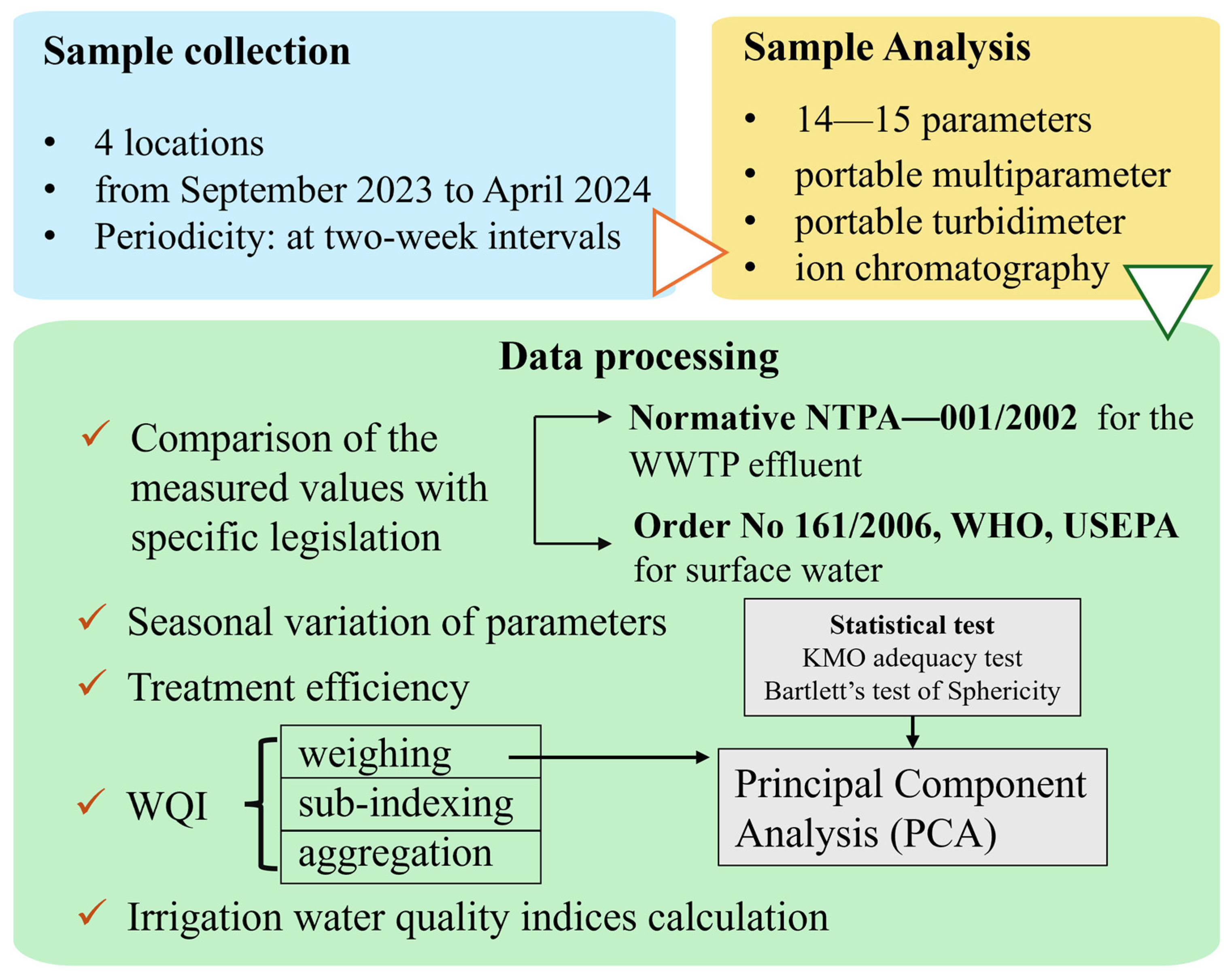
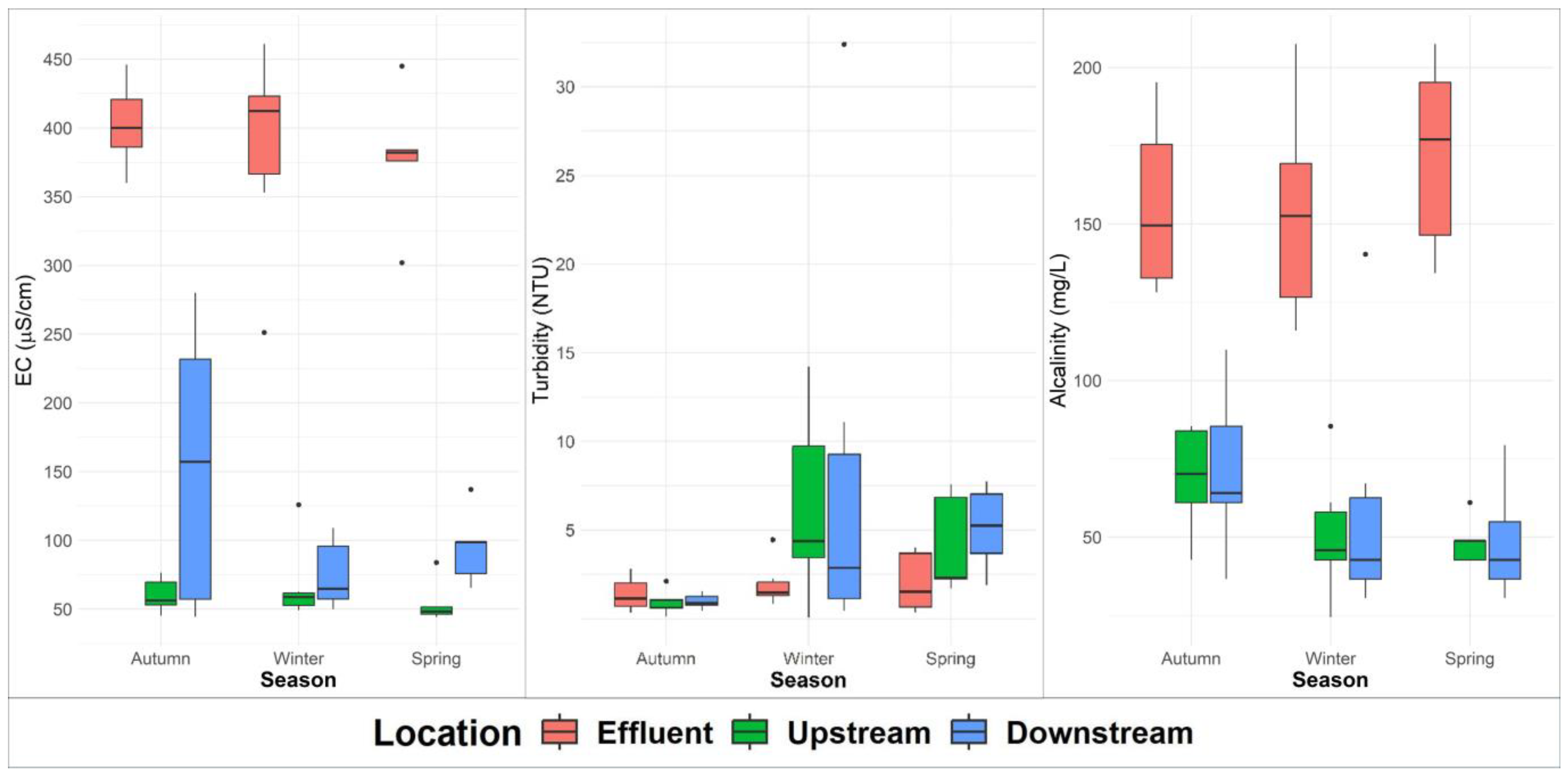
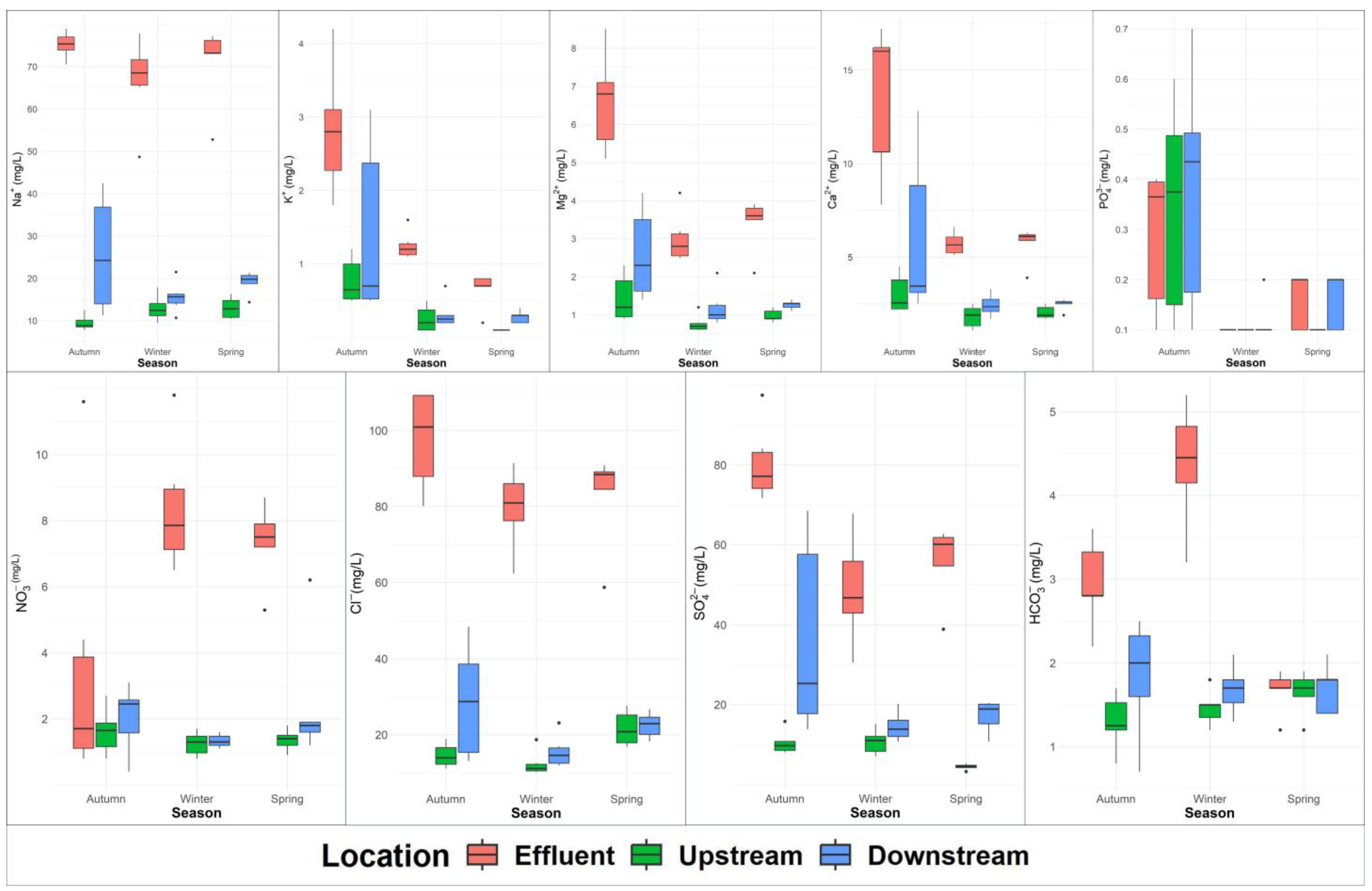
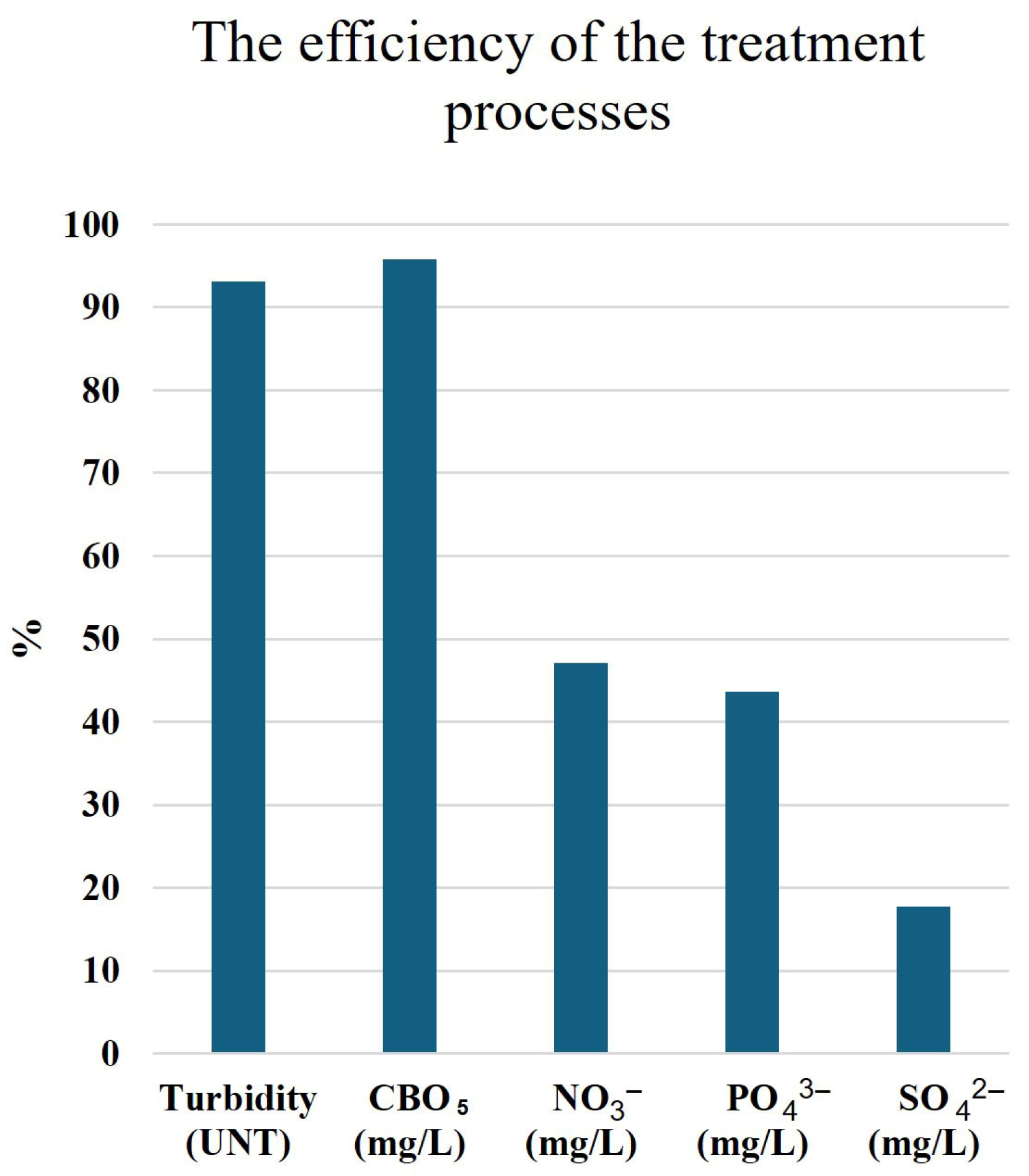
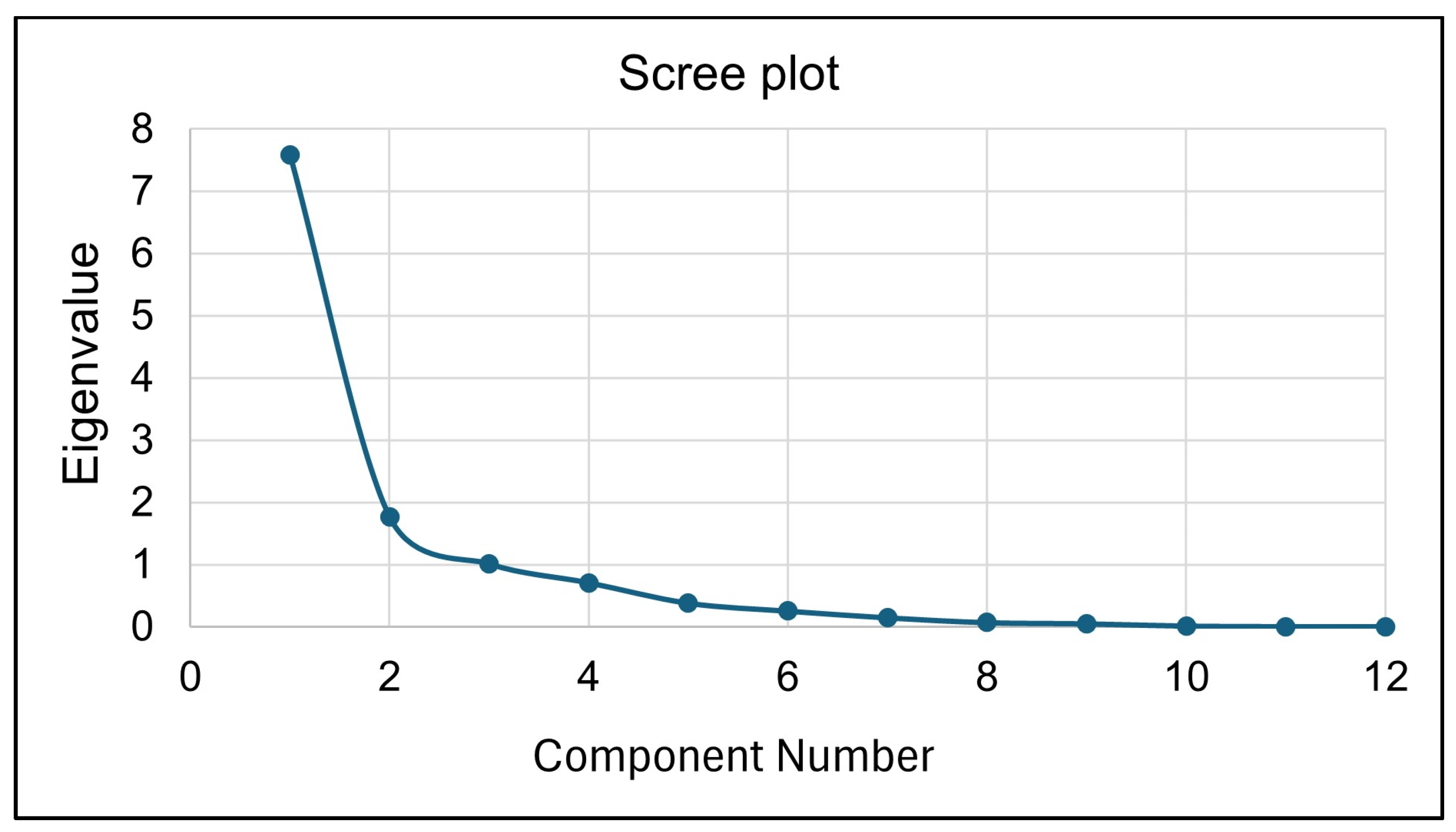
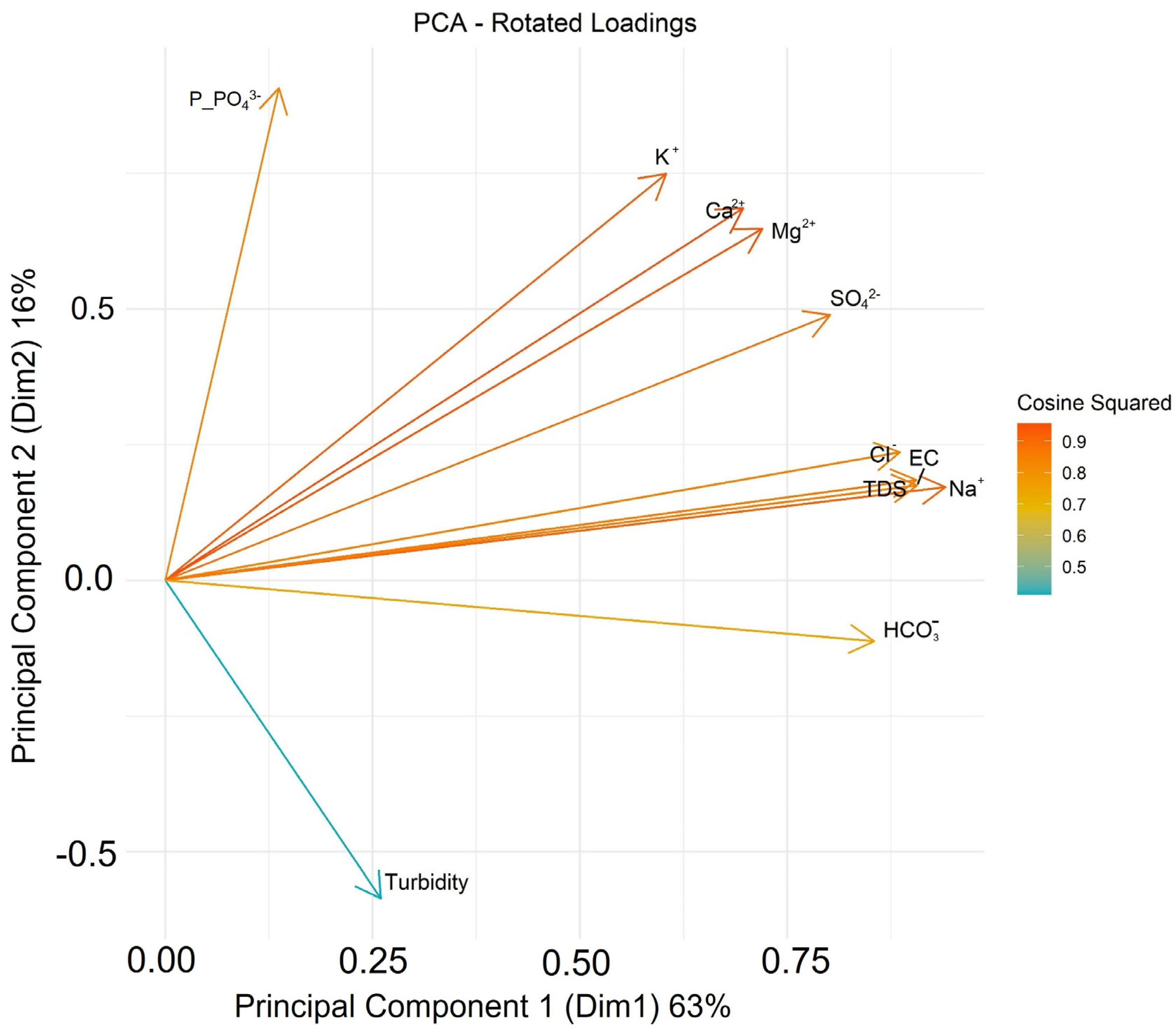
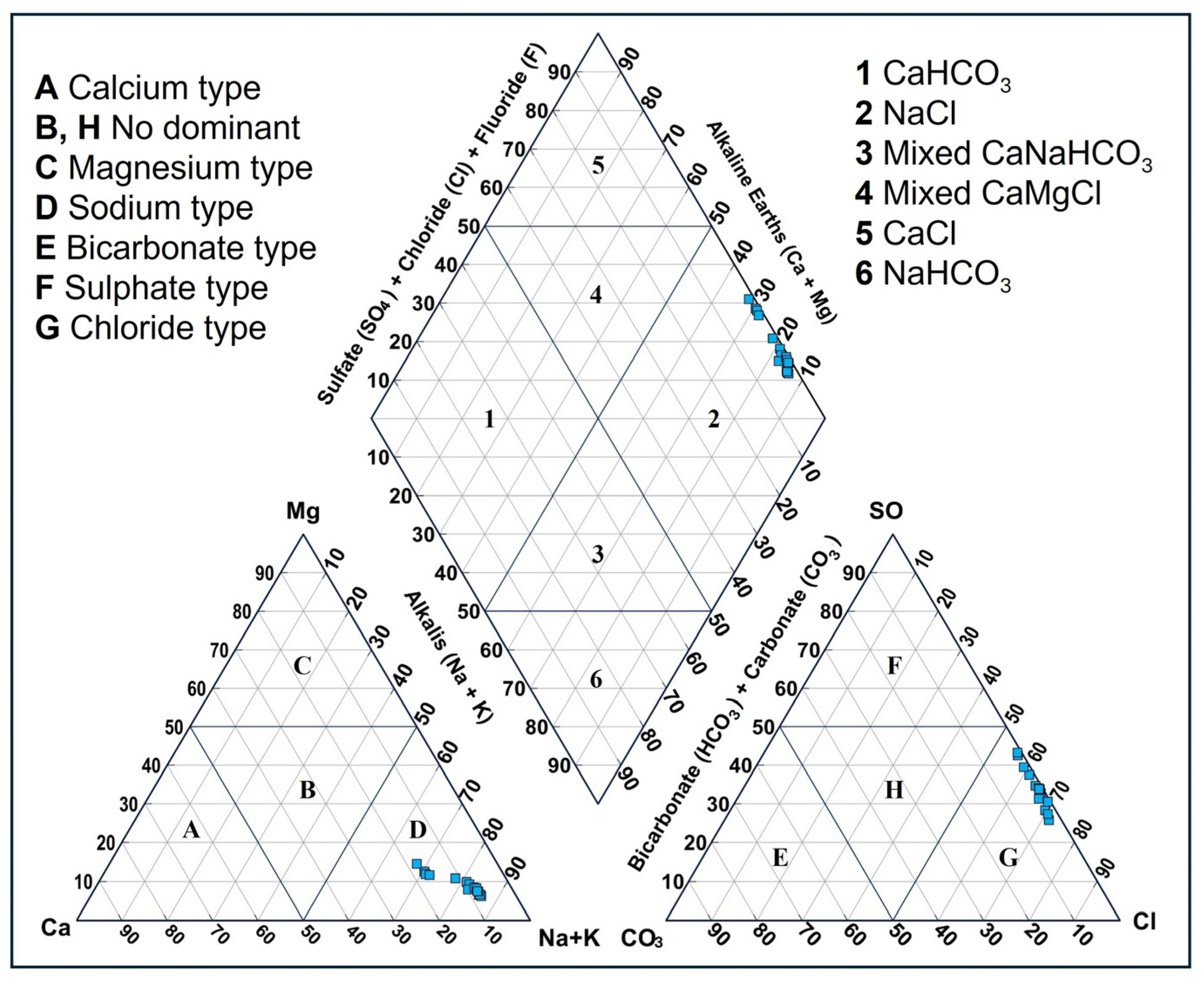
| Parameters | Mean (M) | Min | Max |
|---|---|---|---|
| Turbidity (NTU) | 26 | 7.04 | 80.7 |
| BOD5 (mg/L) | 88.65 | 48 | 156 |
| NO3− (mg/L) | 12.03 | 4.4 | 24.8 |
| SO42− (mg/L) | 75.23 | 32.8 | 98.2 |
| PO43− (mg/L) | 0.33 | 0.1 | 0.6 |
| Component | Initial Eigenvalues | Extraction Sums of Squared Loadings | Rotation Sums of Squared Loadings | ||||||
|---|---|---|---|---|---|---|---|---|---|
| Total | % of Variance | Cumulative % | Total | % of Variance | Cumulative % | Total | % of Variance | Cumulative % | |
| 1 | 7.578 | 63.151 | 63.151 | 7.578 | 63.151 | 63.151 | 6.210 | 51.748 | 51.748 |
| 2 | 1.768 | 14.733 | 77.884 | 1.768 | 14.733 | 77.884 | 3.019 | 25.160 | 76.907 |
| 3 | 1.015 | 8.456 | 86.340 | 1.015 | 8.456 | 86.340 | 1.132 | 9.432 | 86.340 |
| 4 | 0.710 | 5.920 | 92.260 | ||||||
| 5 | 0.382 | 3.182 | 95.442 | ||||||
| 6 | 0.255 | 2.122 | 97.564 | ||||||
| 7 | 0.147 | 1.227 | 98.791 | ||||||
| 8 | 0.070 | 0.587 | 99.378 | ||||||
| 9 | 0.051 | 0.423 | 99.800 | ||||||
| 10 | 0.014 | 0.121 | 99.921 | ||||||
| 11 | 0.006 | 0.051 | 99.972 | ||||||
| 12 | 0.003 | 0.028 | 100.000 | ||||||
| Component Loading | |||
|---|---|---|---|
| Eigenvalue | 6.210 | 3.019 | 1.132 |
| Relative eigenvalue | 0.599 | 0.291 | 0.109 |
| Parameters | PC1 | PC2 | PC3 |
| Na+ | 0.941 | 0.172 | 0.133 |
| Mg2+ | 0.720 | 0.648 | 0.069 |
| Ca2+ | 0.697 | 0.686 | 0.016 |
| Cl− | 0.886 | 0.236 | 0.120 |
| N_NO3− | 0.254 | −0.011 | 0.897 |
| SO42− | 0.802 | 0.489 | 0.107 |
| P_PO43− | 0.137 | 0.907 | −0.093 |
| Turbidity | 0.260 | −0.586 | −0.413 |
| EC | 0.907 | 0.175 | 0.188 |
| TDS | 0.906 | 0.185 | 0.192 |
| K+ | 0.604 | 0.749 | 0.067 |
| HCO3− | 0.855 | −0.112 | −0.154 |
| PCA Components and Indicators | Relative Eigenvalue | Rotated Loading | Relative Loading | Weight (Relative Eigenvalue x Relative Loading) |
|---|---|---|---|---|
| PC 1—Salinity and mineralization | ||||
| Na+ | 0.941 | 0.1285 | 0.0770 | |
| Mg2+ | 0.720 | 0.0983 | 0.0589 | |
| Ca2+ | 0.697 | 0.0953 | 0.0571 | |
| Cl− | 0.886 | 0.1211 | 0.0726 | |
| SO42− | 0.802 | 0.1096 | 0.0657 | |
| EC | 0.907 | 0.1239 | 0.0743 | |
| TDS | 0.599 | 0.906 | 0.1238 | 0.0742 |
| K+ | 0.604 | 0.0825 | 0.0495 | |
| HCO3− | 0.855 | 0.1169 | 0.0700 | |
| Total | 7.319 | 1 | ||
| PC 2—Organic matter and phosphate pollution | ||||
| P_PO43− | 0.907 | 0.6074 | 0.1770 | |
| Turbidity | 0.291 | 0.586 | 0.3926 | 0.1144 |
| Total | 1.493 | 1 | ||
| PC 3—Nitrate pollution | ||||
| N_NO3− | 0.109 | 0.897 | 1 | 0.1092 |
| WQI | ||||
|---|---|---|---|---|
| Season | Upstream Samples | Mean Value WQI | Downstream Samples | Mean Value WQI |
| Autumn | ||||
| 12 September 2023 | 47.7 | 75.2 | ||
| 29 September 2023 | 52.5 | 92.1 | ||
| 13 October 2023 | 32.3 | 38.6 | ||
| 27 October 2023 | 41.9 | 46.2 | ||
| 10 November 2023 | 22.8 | 47.0 | ||
| 24 November 2023 | 22.4 | 27.1 | ||
| Winter | ||||
| 8 December 2023 | 29.3 | 25.6 | ||
| 22 December 2023 | 18.0 | 34 | 20.5 | 47 |
| 10 January 2024 | 26.7 | 31.1 | ||
| 19 January 2024 | 27.1 | 24.7 | ||
| 2 February 2024 | 51.3 | 51.7 | ||
| 16 February 2024 | 50.8 | 101.5 | ||
| Spring | ||||
| 1 March 2024 | 36.2 | 48.4 | ||
| 15 March 2024 | 38.7 | 43.9 | ||
| 29 March 2024 | 30.6 | 53.1 | ||
| 12 April 2024 | 26.7 | 38.5 | ||
| 26 April 2024 | 23.6 | 36.8 | ||
| Samples | Season | EC (µS/cm) | TDS (mg/L) | Turbidity (NTU) | BOD5 (mg/L) | SAR | PI% | RSC | %Na | KR |
|---|---|---|---|---|---|---|---|---|---|---|
| Autumn | ||||||||||
| 1 | 12 September 2023 | 392 | 255 | 1.45 | 15.3 | 3.89 | 74.45 | −1.36 | 70.32 | 2.32 |
| 2 | 29 September 2023 | 360 | 234 | 0.81 | 8.7 | 3.61 | 72.18 | −1.51 | 67.64 | 2.04 |
| 3 | 13 October 2023 | 408 | 265 | 0.36 | 2.7 | 3.96 | 75.05 | −1.33 | 70.90 | 2.38 |
| 4 | 27 October 2023 | 446 | 290 | 2.2 | 4.6 | 4.09 | 76.36 | −1.30 | 71.93 | 2.48 |
| 5 | 10 November 2023 | 384 | 250 | 2.79 | 1.6 | 4.63 | 83.16 | −0.83 | 78.03 | 3.49 |
| 6 | 24 November 2023 | 425 | 276 | 0.66 | 2.1 | 5.37 | 85.28 | −0.78 | 81.01 | 4.21 |
| Winter | ||||||||||
| 7 | 8 December 2023 | 353 | 229 | 4.46 | 0.4 | 5.23 | 87.92 | −0.63 | 81.98 | 4.49 |
| 8 | 22 December 2023 | 251.15 | 163.52 | 1.5 | 0.8 | 4.40 | 92.09 | −0.40 | 82.26 | 4.57 |
| 9 | 10 January 2024 | 425 | 276 | 0.81 | 3.2 | 6.11 | 93.36 | −0.45 | 85.75 | 5.95 |
| 10 | 19 January 2024 | 417.39 | 271.03 | 1.43 | 1.6 | 5.78 | 93.24 | −0.43 | 85.32 | 5.75 |
| 11 | 2 February 2024 | 407 | 264 | 1.27 | 2.7 | 5.89 | 94.00 | −0.39 | 86.07 | 6.12 |
| 12 | 16 February 2024 | 461 | 300 | 2.24 | 0.6 | 6.30 | 92.81 | −0.49 | 85.54 | 5.87 |
| Spring | ||||||||||
| 13 | 1 March 2024 | 445 | 296 | 1.51 | 1.8 | 5.65 | 87.04 | −0.62 | 83.46 | 5.01 |
| 14 | 15 March 2024 | 376 | 244 | 0.67 | 8.2 | 5.75 | 88.39 | −0.58 | 83.94 | 5.20 |
| 15 | 29 March 2024 | 384 | 244 | 4.03 | 2.1 | 6.07 | 89.01 | −0.57 | 84.82 | 5.55 |
| 16 | 12 April 2024 | 382 | 249 | 3.69 | 5.4 | 6.05 | 88.96 | −0.58 | 84.58 | 5.46 |
| 17 | 26 April 2024 | 302 | 198 | 0.37 | 1 | 5.33 | 92.38 | −0.34 | 86.15 | 6.20 |
Disclaimer/Publisher’s Note: The statements, opinions and data contained in all publications are solely those of the individual author(s) and contributor(s) and not of MDPI and/or the editor(s). MDPI and/or the editor(s) disclaim responsibility for any injury to people or property resulting from any ideas, methods, instructions or products referred to in the content. |
© 2025 by the authors. Licensee MDPI, Basel, Switzerland. This article is an open access article distributed under the terms and conditions of the Creative Commons Attribution (CC BY) license (https://creativecommons.org/licenses/by/4.0/).
Share and Cite
Ajtai, I.; Anton, A.; Roba, C.; Botezan, C.; Piștea, I.; Oprea, M.; Baciu, C. Wastewater Impact on Surface Water Quality and Suitability of Water Reuse in Agriculture Using a Comprehensive Methodology Based on PCA and Specific Indices. Water 2025, 17, 2011. https://doi.org/10.3390/w17132011
Ajtai I, Anton A, Roba C, Botezan C, Piștea I, Oprea M, Baciu C. Wastewater Impact on Surface Water Quality and Suitability of Water Reuse in Agriculture Using a Comprehensive Methodology Based on PCA and Specific Indices. Water. 2025; 17(13):2011. https://doi.org/10.3390/w17132011
Chicago/Turabian StyleAjtai, Iulia, Anda Anton, Carmen Roba, Camelia Botezan, Ioana Piștea, Marius Oprea, and Călin Baciu. 2025. "Wastewater Impact on Surface Water Quality and Suitability of Water Reuse in Agriculture Using a Comprehensive Methodology Based on PCA and Specific Indices" Water 17, no. 13: 2011. https://doi.org/10.3390/w17132011
APA StyleAjtai, I., Anton, A., Roba, C., Botezan, C., Piștea, I., Oprea, M., & Baciu, C. (2025). Wastewater Impact on Surface Water Quality and Suitability of Water Reuse in Agriculture Using a Comprehensive Methodology Based on PCA and Specific Indices. Water, 17(13), 2011. https://doi.org/10.3390/w17132011








